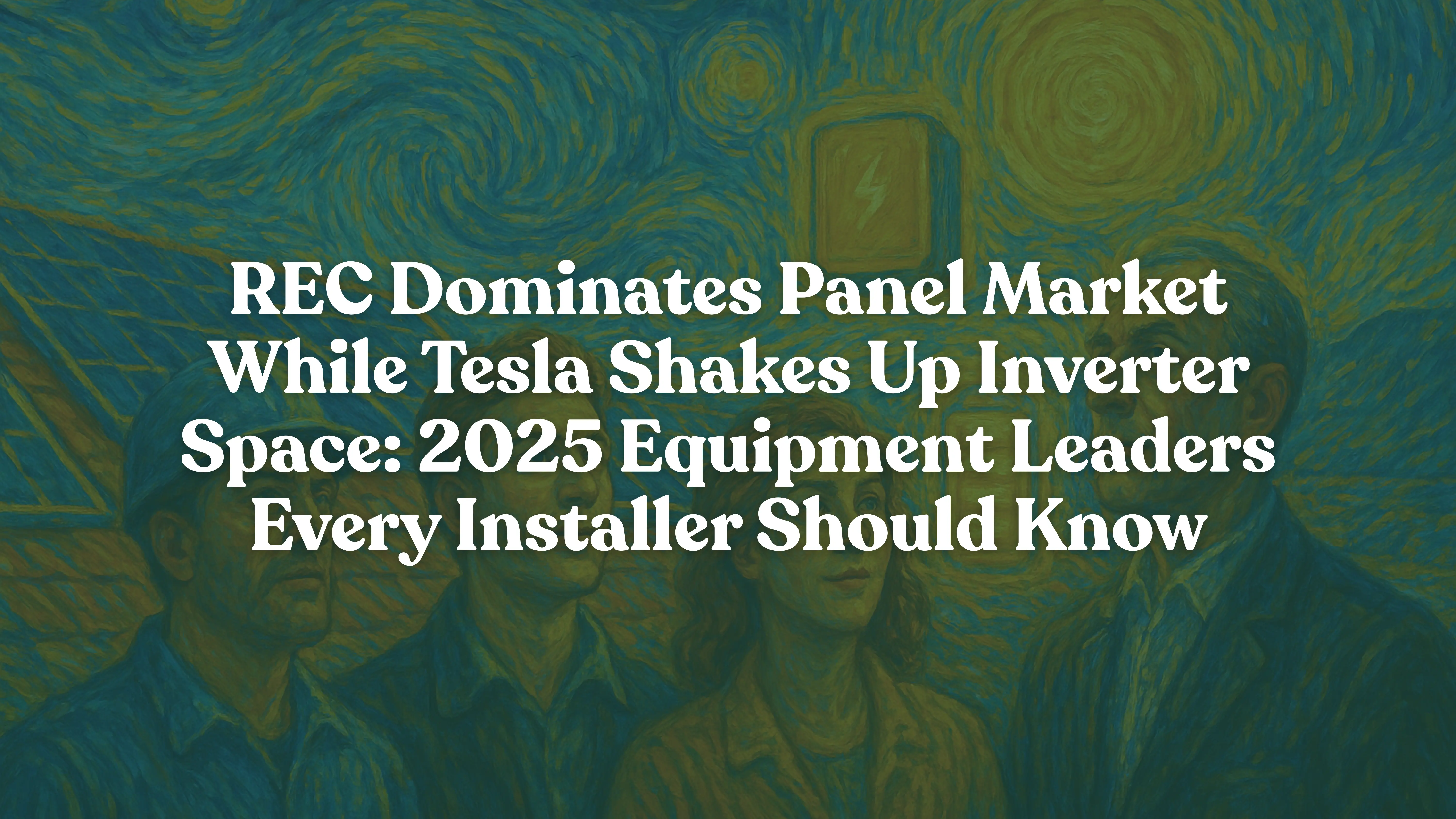Residential Solar Equipment Market Share: 2025 Data

Residential Solar Equipment Market Share 2025: REC Leads Panels at 43% While Tesla Disrupts Inverters
Introduction: Understanding Today’s Solar Equipment Landscape
The residential solar equipment market share landscape transformed dramatically in 2025. New leaders emerged while established brands defended their positions. For US solar installers and EPCs, knowing which equipment dominates helps streamline procurement decisions and boost customer satisfaction.
Market data from EnergySage reveals surprising shifts. Panel manufacturers consolidated power. Inverter markets saw unprecedented disruption. Battery attachment rates soared across key states. Let’s explore what these changes mean for your installation business.
Which Solar Panel Brands Lead the Market in 2025?
REC Dominates with 43% Market Share
REC solar panels market share reached an impressive 43% in the first half of 2025. This represents the highest concentration for any single panel manufacturer in recent years. Installers choose REC for consistent availability and proven reliability.

Qcells maintains second place with 12% market share. Meanwhile, Hyperion Solar jumped to third position at 9%. This rapid rise demonstrates how supply chain reliability matters more than brand legacy during uncertain times.
Other Notable Panel Manufacturers
Several established brands round out the market:
- Panasonic (focusing on premium residential)
- Jinko Solar (competitive pricing)
- Silfab Solar (North American manufacturing)
- Trina Solar (commercial crossover success)
- SEG Solar (regional strength in Southeast)
- Mission Solar (Texas manufacturing advantage)
- Longi Solar (global scale benefits)
Check out Top 5 States Where Solar Installers Are Thriving Despite ITC Expiration
How Did Tesla Transform the Inverter Market?
Tesla Powerwall 3 Changes Everything
The inverter segment experienced its biggest disruption in years. Tesla Powerwall market share in storage reached 47% while their inverter offerings captured significant ground. Tesla’s integrated inverter-battery solution appeals to installers seeking simplified installations.

Enphase maintains overall inverter leadership. However, Tesla secured second place ahead of traditional leader SolarEdge. The top three solar inverter manufacturers now control 93% of quoted projects—unprecedented market concentration.
Regional Inverter Preferences Vary
Different markets show distinct preferences:
- California: Enphase dominates with premium positioning
- Texas: Price-sensitive market favors value brands
- Florida: Hurricane-rated equipment takes priority
- Northeast states: Cold weather performance matters most
Visit Energy.gov for inverter efficiency standards
What Are Current Battery Attachment Rates by State?
Storage Becomes Standard, Not Optional
Battery attachment rates solar installations show explosive growth nationwide. The data reveals massive regional variations that smart installers can leverage:
| State | Battery Attachment Rate | Market Opportunity |
|---|---|---|
| Hawaii | 100% | Mandatory requirement |
| California | 79% | NEM 3.0 driving adoption |
| Texas | 61% | Grid reliability concerns |
| Arizona | 47% | Peak shaving benefits |
| Utah | 44% | Time-of-use optimization |
| Florida | 43% | Hurricane backup power |
| Illinois | 25% | Growing awareness |

Price Dynamics Impact Installation Strategies
Battery prices increased to $1,032 per kWh in early 2025. This follows steady declines from $1,352 in 2023. New tariffs on imports caused the uptick. Installers must adjust pricing strategies accordingly.
Which Equipment Suppliers Offer Best Installer Support?
Top Residential Solar Equipment Manufacturers Rankings
The best solar panel brands for installers 2025 combine product quality with dealer support. Our analysis of residential solar installers equipment preferences reveals clear winners:
Panel Manufacturers Support Quality:
- REC – Comprehensive training programs
- Qcells – Quick warranty processing
- Silfab – Dedicated installer hotline
Inverter Support Excellence:
- Enphase – Extensive online resources
- Tesla – Streamlined app integration
- SolarEdge – Technical certification programs
Regional Market Insights for Smart Procurement
California Market Specifics
California installers face unique challenges. Net billing transitions drive storage adoption. The 79% battery attachment rate creates opportunities for integrated solutions. Focus on solar battery storage market leaders like Tesla and Enphase.
Texas Installation Trends
Texas presents different dynamics. Grid reliability concerns push battery adoption to 61%. Price sensitivity remains high. Consider value-oriented brands while maintaining quality standards.
Southeast Regional Patterns
Florida and neighboring states prioritize hurricane resistance. Equipment certifications matter more than price. Stock wind-rated mounting systems and secure battery enclosures.
Your Solar Installer Equipment Procurement Guide
Strategic Inventory Management
Smart procurement follows market trends. Stock market-leading brands to ensure availability. However, maintain relationships with emerging suppliers for flexibility. This solar installer equipment procurement guide helps optimize your approach:
- Primary inventory: Top 3 brands per category
- Secondary options: Rising competitors with good support
- Specialty products: Regional or application-specific needs
- Emergency backup: Alternative suppliers for disruptions

Training Investment Priorities
Focus technician training on market leaders:
- REC panel installations and warranty procedures
- Tesla Powerwall 3 commissioning and app setup
- Enphase microinverter troubleshooting
- Rapid shutdown compliance for all systems
Positioning for Success in 2025
The residential solar equipment market share data reveals clear winners and emerging trends. REC’s 43% panel dominance, Tesla’s inverter disruption, and soaring battery attachment rates reshape installation strategies nationwide.
Successful installers align with market leaders while maintaining flexibility. Build expertise with top brands. Understand regional variations. Most importantly, use market data to make informed procurement decisions.
The equipment landscape continues evolving rapidly. However, installers who track market share trends and adapt quickly will thrive. Focus on proven equipment, strong manufacturer relationships, and excellent customer service.
Ready to optimize your equipment strategy? Start by standardizing on market leaders. Then build flexibility through diverse supplier relationships. Your customers trust you to choose reliable equipment—market share data helps justify those decision.
Standardize on Winners — Engineer with Confidence
REC’s 43% panel dominance and Tesla/Enphase strength in storage and inverters mean installers should standardize on proven equipment while keeping flexible supplier options.
Energyscape Renewables delivers fast, permit-ready engineering, PE-stamping, interconnection and storage-ready designs—helping you pick compatible gear, reduce rework, and speed approvals so installations stay profitable.
Combine that with Sunscape (Solar CRM + Site Survey App) to capture accurate site data, automate procurement-friendly workflows, and scale without sacrificing quality.

sjayakanth@energyscaperenewables.com